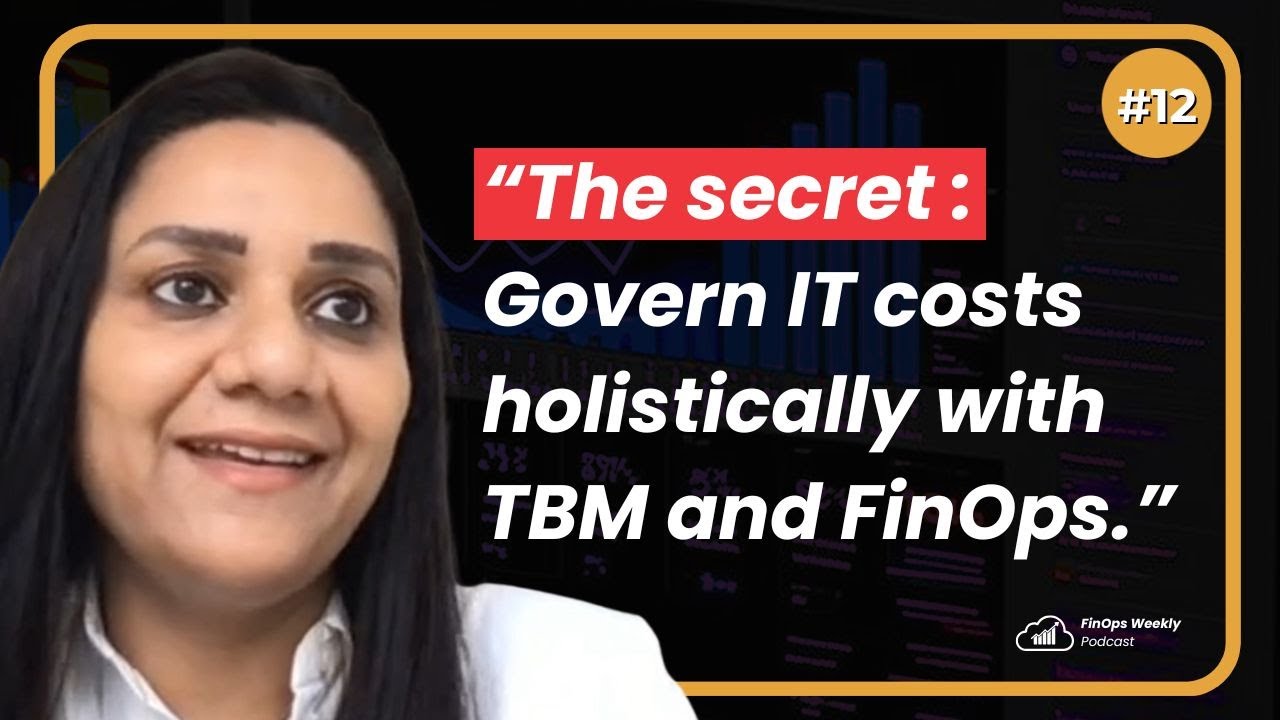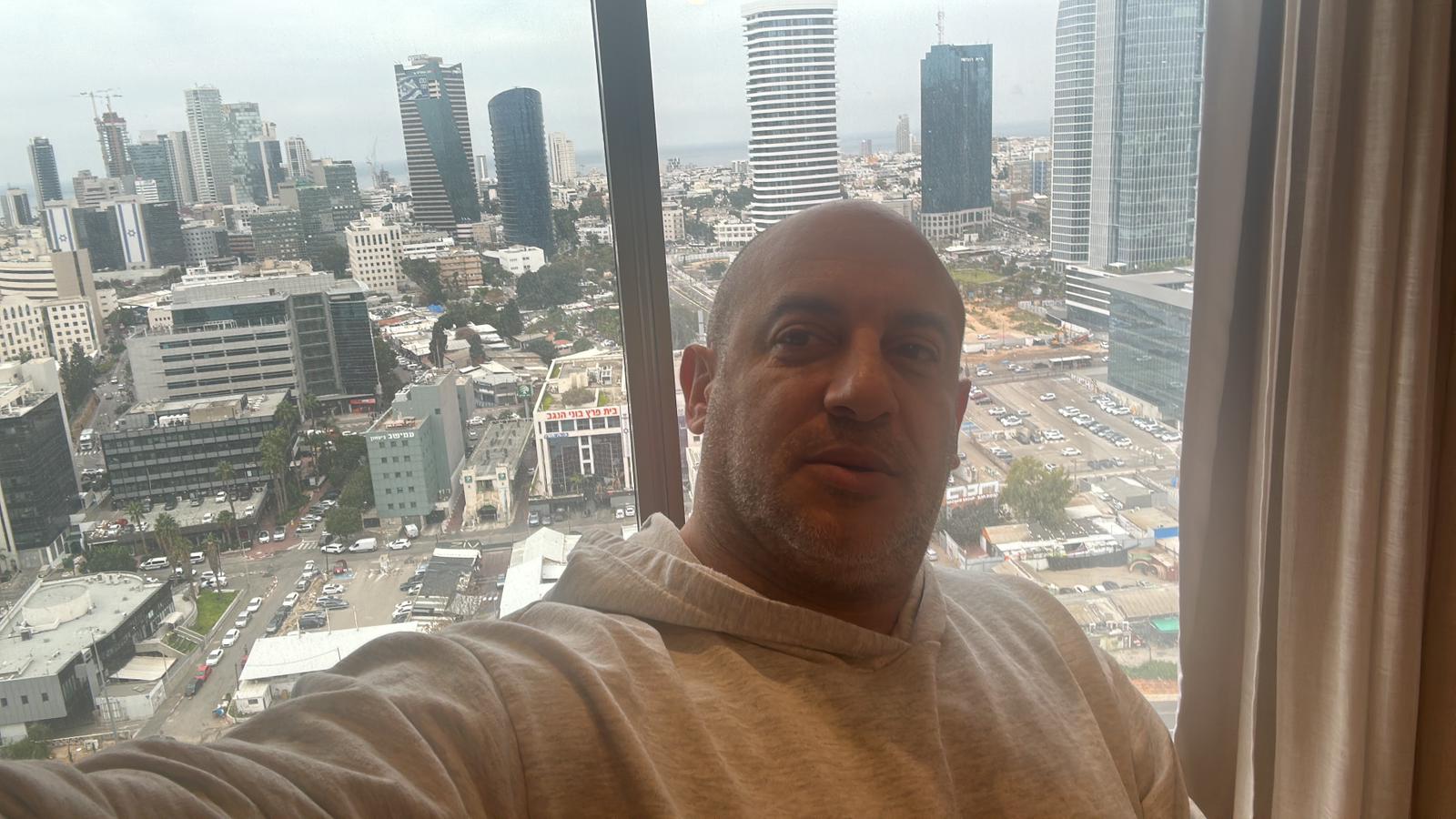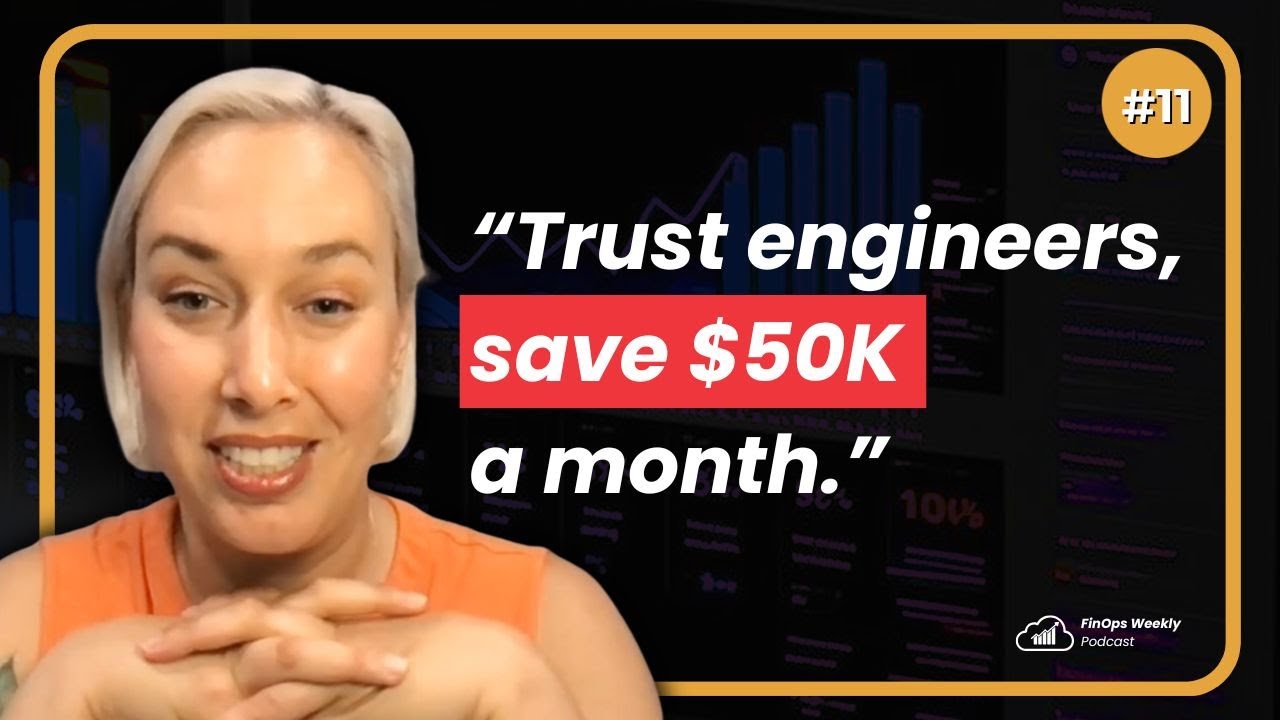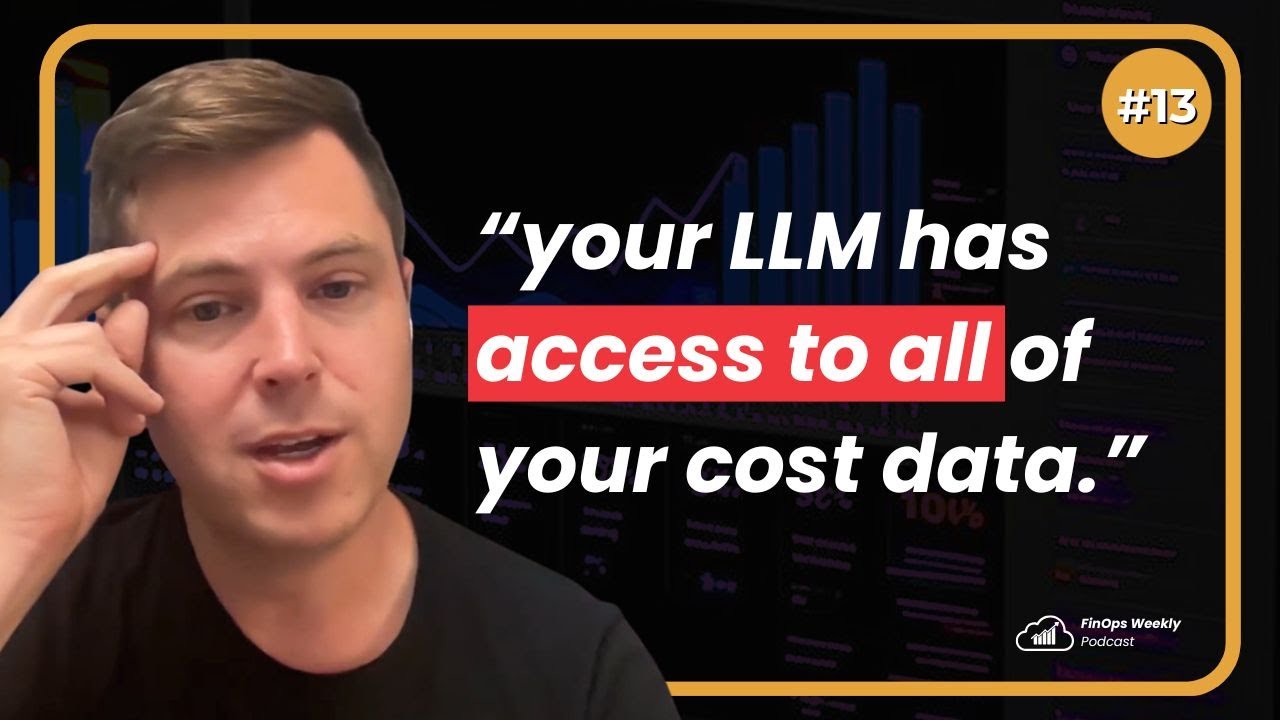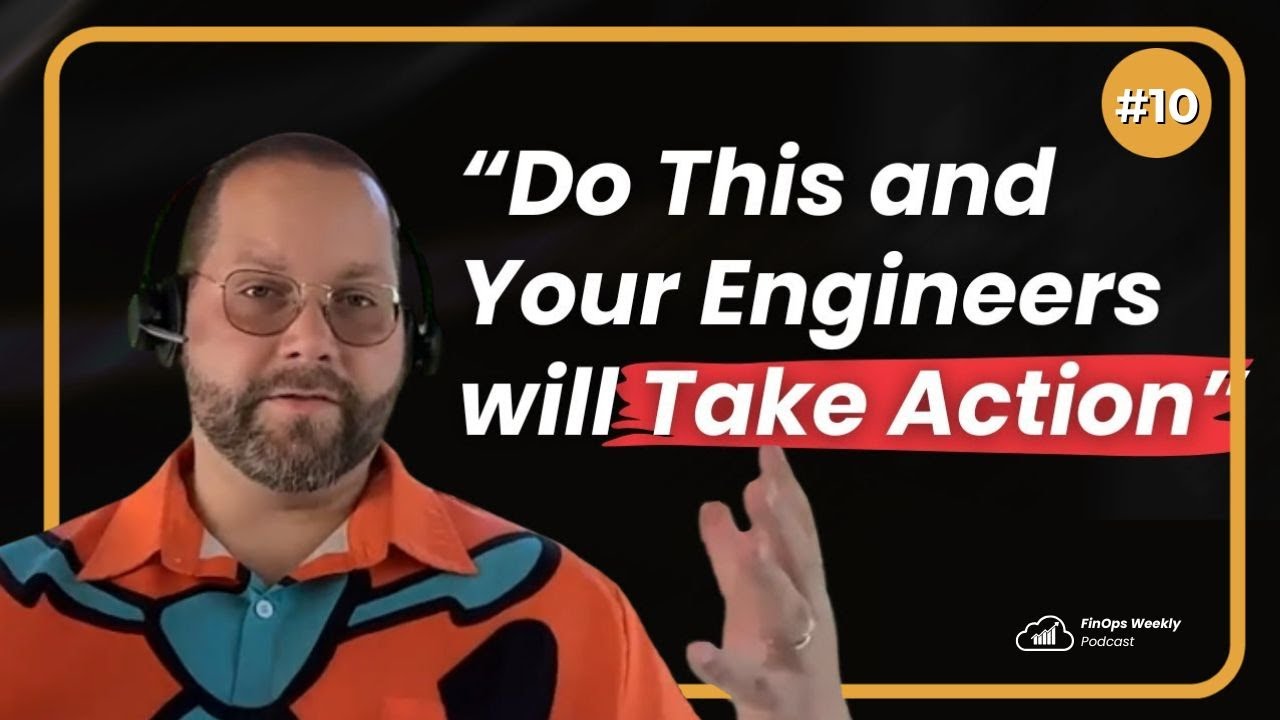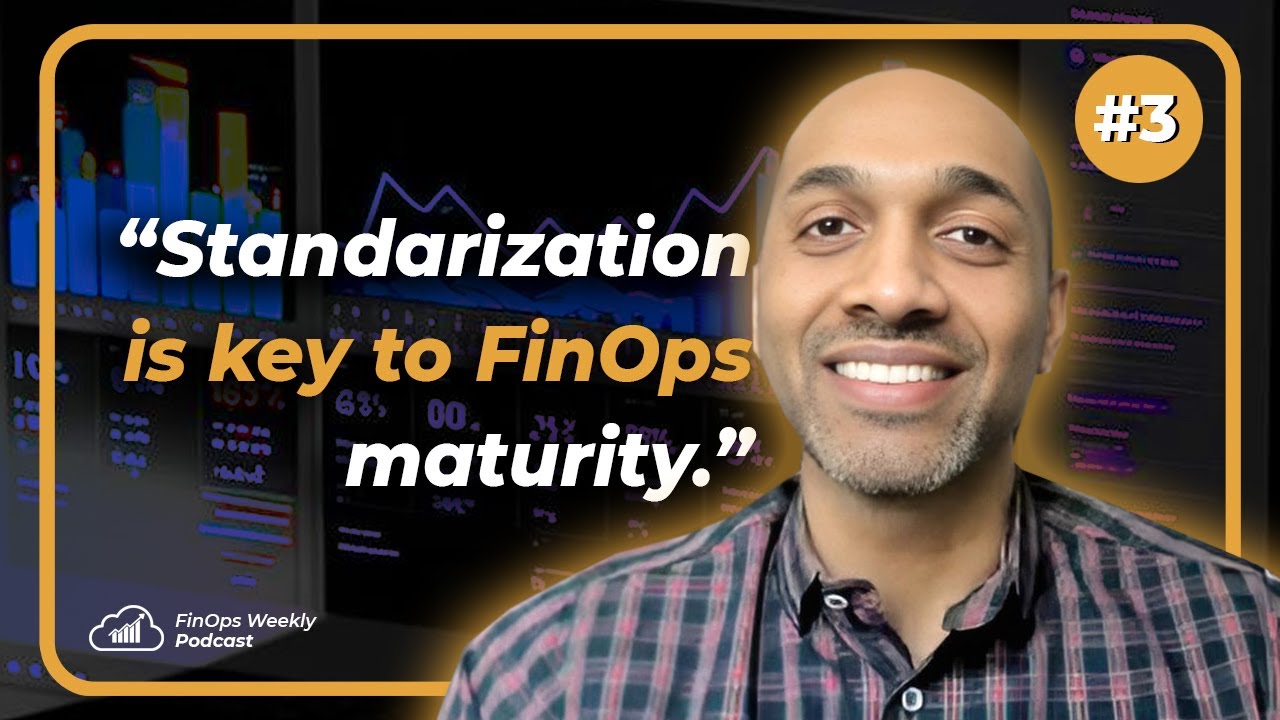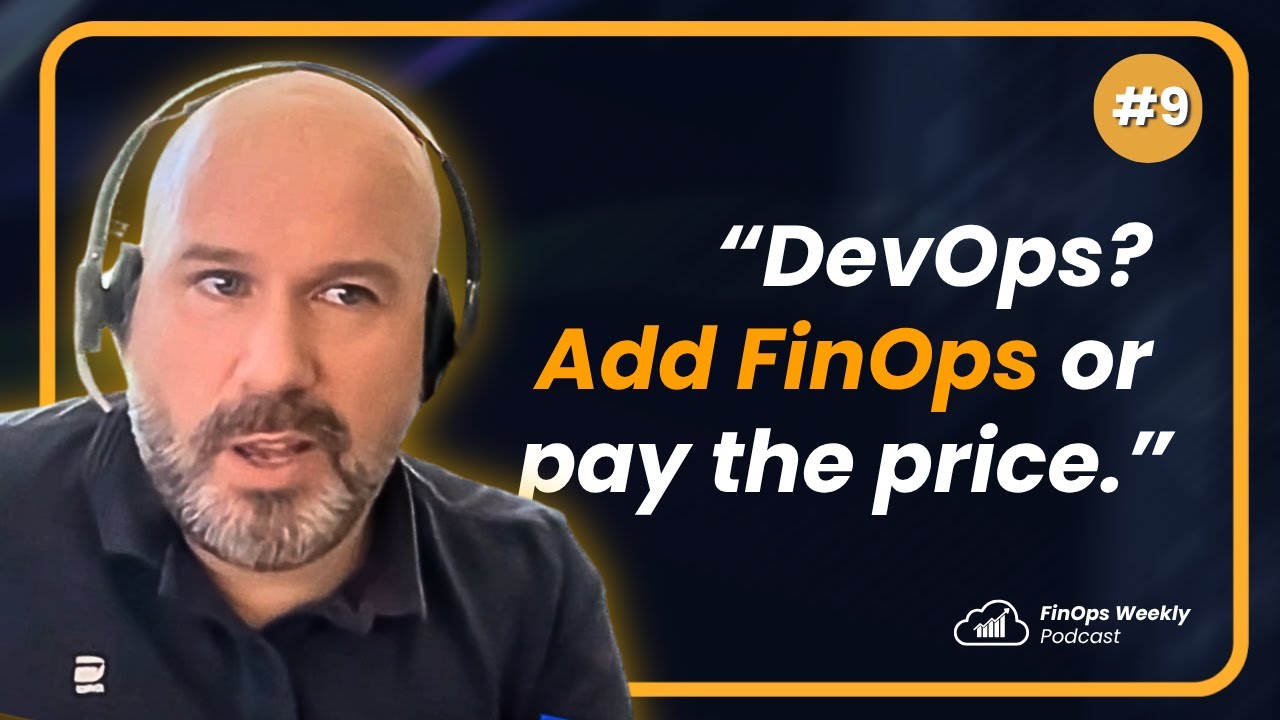Episode Transcript
[00:00:00] Speaker A: Welcome everyone to a new episode of the FinOps weekly podcast. And today we are going to talk about TBM, this concept that has been related to FinOps. And we had several comments on social media and what it is and you know, explaining a bit the connection of it to Phenups and to bring some light into it, we have Nilofar with us. How are you Nilofar?
[00:00:22] Speaker B: I'm good, Victor, thank you. Hope you're well too.
[00:00:26] Speaker A: And also of course, Damian, Damien, how are you?
[00:00:31] Speaker C: I'm doing great, thank you. Thank you for joining us.
Great day today.
[00:00:36] Speaker A: Yeah, it's going to be an interesting conversation because when I can break a lot of context. When I joined the FinOps ecosystem and started to learn about it, we come about this concept of tbm. I saw there was references, a lot of, you know, reference to multiple topics, but then was itam, ITSM and then was tbm and for me tbm I wasn't very sure about what, what IT is. And today probably for people that are starting and are not very familiar into this topic, we want to bring some light about what IT is, how it relates to finops and how it can be important for your practice. So Nilofar, just starting with the basic question for the audience, what is tbm? So we can explain to the audience.
[00:01:22] Speaker B: TBM Technology Business management is a discipline where your IT spend can be governed in both aspects. So a running a business and B changing a business. So when you run the business, it's important that your IT spend is in alignment with the business outcome that you want to bring.
At the same time, it also gives you the business. It also gives you. It also gives your business the ability to change. So for example, keeping up with the innovation, bringing enterprise agility. So both these aspects, running the business and changing the business in light of IT spend is the framework called TBM Technology Business Management brilliant framework. I'm huge fan of TBM actually and specifically is around that every spend in IT has to bring business value you in olden days it used to be a cost center, not like a strategic partner for business. In past 20, 30 years the change what we have seen is that most companies are technology company, they're technology focused. So it is not just as in the support function but to bring more innovation in your products.
If you are like for example a retail company, making sure that you are reaching far more geography better, your customer experience is better.
All this we can achieve only when you have a robust IT strategy in place with a strong budget. And to govern this budget, this TBM framework came to existence.
[00:03:06] Speaker A: Thanks for that thoughtful explanation. I think now it's more integrated so you need to understand that it's connected to the business and you need to now is to move the IT spend on the IT consumption to a business relevant metrics and there is a framework by the TBM Council if I'm not mistaken that handles all of that and you can. I'll probably leave the link in the description so you can check it all the taxonomy, all the stuff that has been updated.
[00:03:37] Speaker C: I wanted to add something I think first of all I met Nilofar in the phenomena so well we met. It was great if I remember correctly that JR said that or there was a lot of talks about that the phenops need to be best friends with the TBM or something like that.
[00:03:57] Speaker B: I don't remember if JR has said this or not, but I fully agree with the statement that finops and TBM should be best friends.
When we talk about finops it's mainly around cloud finops. So it's about variable spending of cloud. We are talking about hyperscaler. If you are not careful in one day your spend could go up to a million dollar and we won't be surprised by that. Right.
And then TBM is there to govern your IT spend so it has to work hand in hand and yes, they have to be best friends. So I agree with this statement and I like this statement actually now thank you.
It was absolute pleasure meeting you in Finops X Barcelona. Finops X in San Diego.
[00:04:43] Speaker A: Good deal, Good deal. And you know talking about the synergies and the synergies between FinOps and TBM. So for someone that doesn't or maybe it's in the finops practice that is more, you know, used to it. How or which synergies do you think are between FinOps and TBM and where do you think that is starting to connect? Let's say which points do the connection be easier than others?
[00:05:14] Speaker B: Okay, so the way I see it is more like TBM is more a top down sort of discipline where it's very strategic where the. Where your C level would already make a decision on going for let's say like particular ERP system. Right.
And FinOps is more like a bottom up sort of discipline. So where the engineers are in charge or well engineer has ability to write couple of line of code and spend your company's money. So it kind of meets in the middle I would say where a strategic IT decision has to be communicated well to engineers and then it would enable engineers to make the right decisions for the organization. So I guess it kind of meets in the middle when on the execution layer side of it.
[00:06:13] Speaker A: Okay, good deal.
So for example, just connecting the topics maybe when the unit economics and all these business value related are getting information from the billing and for all this granular data from cloud or for any other provider, is that where connects to tbm?
[00:06:37] Speaker B: It kind of does.
Because see TBM would have different cost centers, right? So it can be internal labor, external labor, it could be about different hardware, software cost. Right. These are all different cost pools that would align and make different cost towers and cost tower when we talk about is the application layer, it's about the data center cost, about the delivery, it's about new application deployment or the IT management, stuff like that. That would be different cost hours and that cost hours would create different solutions for business. And at the end on top of the solution it's business value. So that's how the whole TBM framework or I would say the TBM structure is.
And for finops it's finops is a part of TBM if I'm, if I say it correctly. So for example, if it's any hardware cost, any infrastructure cost, that's a cost pool or sorry a cost center in TBM which would align to different solutions and bring business value. But at the end it's an infrastructure cost of cloud which is a cost which would come under cost pool of TBM framework.
[00:07:54] Speaker C: I guess now that another synergy that we can talk about or add to that is now that the focus is trying to reach another area like SAS and the data centers, maybe that's another key area in which they can collaborate and basically help the business while presenting providing insights.
And of course after we implement.
[00:08:24] Speaker B: The.
[00:08:24] Speaker C: Focus standard into the data centers, then I guess that you would create interesting dashboards and see how all the IT operation and kind of like separated between the infrastructure, the cloud and stuff like that.
[00:08:42] Speaker B: Yeah, 100%. 100%.
Because at the end of the day, look, both the discipline, the objective is to make sure that the spend of it is very strategic.
The spend of it should bring business value.
But how is that? That's when we come in place, right? That's where we have to bring that sort of visibility to business. And Victor, what you touched upon earlier about the unit economics, right? Sometimes in finops it's easier to calculate unit economics when you're talking about the storage cost, compute cost, right?
But when you talk about business side of the unit economics that would differ from each business, each Industry you are in, whether you are oil and gas industry probably would look want to look at some different sort of cost metrics when you are in retail, when you're in E commerce, when you're a SaaS company then you probably want to look at the different unit economics which would be more in alignment with business. So that would also have an aspect of TBM embedded TBM like labor cost for example fixed labor cost, your FTEs or your contractors or the third party providers, what you're using that should also be considered when you're talking about TBM unit metrics. So there's a very strong synergy, strong alignment. And again there's another topic we could touch on here is like scope of finops. Right? Because now when you talk about licensing cost or data center cost, previously it was just part of TBM. Now in FinOps because we are expanding, we are in the cloud plus era of FinOps then there's very strong alignment, a good overlap and a good synergy I would say has to be there in both disciplines.
I mean I particularly in my opinion I feel that it's the best way to govern your IT cost holistically.
If you're just looking at finops and cloudsman probably you're missing out the bigger picture. If you're looking at TBM but not considering variable cost of cloud, then again you're missing out. So it has to like the businesses and the C level, the leaders has to keep an open eye for both the framework in a synergetic way.
Okay.
[00:11:02] Speaker A: So yeah, having both applied I think it's the best solution especially for large companies that foresee or have large decisions and more strategic decision to make. You can leverage the TVM for the generics and then leverage Finnel for the down to earth calculations and the real numbers that are there. Such as as you mentioned, the unit economics are very varied based on the sector. Like you don't measure, I don't know revenue per shop in a retail market rather than or your website user revenue in a retail and an E commerce rather than in oil and gas that you may make, I don't know the installation or how much time does it take the trading of the oil and the resources. It's very different the business and it's good because it will make you understand better the company and the sector that you're working for. And this is valuable for both work for your career and in for example for financial decision like if you want to, you like to invest and you want to research about a company you probably better understand the the sector.
If you understand the sector, you probably understand whether your company is great and getting better or not. And with that you may be able to get better in your career because at some point and at some levels, board levels, C levels especially all gets down to the numbers and to the sector numbers and to the metrics that drive the business. So that's also valuable if you are C level or not C level, that's valuable information that you should be able to know. I'm talking about the synergies and this collision or let's say this collision, this joint in the, let's say in the private cloud, in the data center cloud. Especially now with the data sovereign or the cloud server and all these regional stuff that we are having. How do you see especially FinOps and TBM being changed now? Because we come from the cloud for the FinOps cloud everything is cloud related but now we are moving to data center regional stuff.
How do you see both TVM and FinOps working on that area of the let's say private cloud, the plus cloud side?
[00:13:28] Speaker B: Yeah. So see like I said, FinOps has expanded its scope, right? Like what you're mentioning that we talked about earlier, that cloud plus era of finops whereas TBM already we're talking about fixed cost.
So at this point it's not only about applying FinOps principle to TDM but applying TDM framework to FinOps as well. So when going forward in this cloudless era we'll have to go left and right and right and left in both direction rather than just use. I mean I know we have used finops phase like inform, operate, optimize cycle but at this time we'll have to consider different fixed cost element to to this cycle. Like for example it's for. For this Finops life life cycle. It works really well in cloud but when it comes to data center and the fixed cost element to that that will be.
There won't be much room for variation. However there will be plenty of room to understand that if the capacity what we plan for a data center is it fully optimized? Are we fully utilizing it? Right. So a utilization part of it would come in picture rather than optimization because once you are in the once you're in certain lease again depending on the agreement, depending on the size of the business, you have this fixed cost whether you're using it or not. So you rather use it or use it in more strategic way and look at the whole picture, whole business picture to utilize your capacity wall. So I guess utilization would we'll have to start using that word more often in finops rather than just. Rather than focusing on optimization side of it.
[00:15:31] Speaker A: Yeah, I guess that when you have the provision capacity you need to now work on utilization and moving about that because previously to cloud there was and one of the reasons that people move into cloud was the variety of the variable moved of cloud so you can spin up instances and you don't have to let's say book or buy servers for a long time. Do you think that after cloud and now that we go to private, let's say a cloud plus system, do you think that that contracts or that provisioning of infrastructure in private cloud will become more agile? Like you would be able to kind of use a cloud approach into your data center or being able to acquire servers easily because before it was like I don't know, a five year contract and you can have that amount of resources and you have a lot of wasted infrastructure because you need to provision for five years.
Do you think that now after going to the cloud and maybe using a hybrid structure there will be more agility in getting a data center infrastructure?
[00:16:44] Speaker B: I think so. And that's how businesses should mold themselves because the agility has to be there. And one beautiful thing about FinOp, the TBM framework is, is that it does talk about business agility when we talk about changing the business it's about innovation in the business and having business agility.
So a data center should adopt in a way that giving flexibility to their customers not having what you just mentioned, that a very long term contract may not be that useful for probably startup may not be useful given the volatile industry, the volatile market, what we are in, there's always change coming in, right? So having those long term leases or fixed contract may not work in future and in future even like data centers or would would also adapt to public cloud sort of principle where you can open your account by using a credit card which I don't, I don't think that should be a right way for enterprise.
I'm not advocating for that but what I'm saying is that that level of agility what public has probably private cloud should also start working on that. To be honest, if you see like different private cloud providers like sep, right they, they are also changing.
You see rather than just focusing on enterprise level clients now you see that SEP4 HANA or their cloud domain has or offering has changed significantly what it used to be five years ago, seven years ago and now, I mean I'm not even talking about 20 years ago, but if only in five to seven years you can see that level of change.
[00:18:28] Speaker A: Interesting. And you know, adding a bit more about that. Do you think that because of the talking about the point that I mentioned before, the regional side, you know, now that we are in a very, let's say trouble ecosystem geopolitical environment that is a bit shaky and there is all this regional restriction that having here and there between us, EU and all these regions. Do you think that providers that are regional or regional providers of cloud services. I don't know, Hetzner obvious cloud, all these that are very focused into Europe or they are in the US And I don't want to that. Do you think they have now a leverage of this private cloud to be able to use a cloud related system but in specific regions? What do you think about that?
[00:19:23] Speaker B: Yeah, I mean like you rightfully said that because it's such a volatile industry, such volatile uncertain geopolitical situation, of course there will be a need where businesses or even the government has to store the data in particular region, making sure there is no cross region duplication as well. I mean with public cloud it's so much easier, right, that you, you have it in one region, but the data residency you could change. Whereas with this private cloud there's more assurance, more assurance to consumers, more assurance if it's a government data, then more assurance to the people of that particular region and that's much more needed. And I would say that's a good change.
And obviously the private cloud providers in this area where they are very focused on their geographic location and security of the data and limiting the data access on that particular region would definitely have some sort of upper hand. They would definitely have some leverage.
But at the same time I would also feel that Hyperscaler, aws, Azure, gcp, they would definitely innovate on this area as well because they definitely see the market. And one service, I would say like something like AWS Outpost. Right. We have seen that coming in for a few years and now a lot of people are using it. I mean the reasons could be different. The reason could be the faster data availability, the late reducing latency, but at the same time now the reason for going for Outpost could be the residency of the data, the geographic location of the data.
[00:21:05] Speaker A: Yeah, indeed. And also the initiatives such as, and the sovereign cloud that Azure spun up I think a week ago or something that has been very marketed across the sectors and all this stuff also moving forward. And maybe I can start with Damien and then I will ask you Nilofar, as Nilofar has said about TBM and the governance and all this stuff and mentioning cost center. So and that's something that we relate to tagging a bit and we relate to being able to granularly obtain that data. Do you think Damian, that for TBM and finops we can have a common point or an agreement to be using tagging on all these allocation strategies to be able to mark where each of the costs should be allocated. Do you think tagging can have a key role in here?
I think that.
[00:22:07] Speaker C: Well of course the more, the more lower you can go, the more data you can get, the better understanding you get from an environment. I think that we touched a little bit about it before. I think that focus is a great opportunity right now to have these two worlds engage and learn one from each other.
While one like Niro Farr was saying it's more focused on the long term and on the business, more value, the other one is in the day to day is how to optimize and there when you have all the data and the more data that you have and the more lower and using tagging and using other techniques you get all this data and you have these two group of people working together. I think that even the sky is not the limit, right?
I guess that we will see many interesting things they're doing on different areas.
And again FinOps is already looking into how start visualizing at least part of what is going on in data centers is looking into SAS and license there.
I think that we have a future that is going to be very interesting even on that.
And again I think that finos will gain also a lot from understanding or looking more into the business.
And it's in a good position as well because it's always working with different teams. It's used to doing that so adding another team, it's not a problem.
[00:23:49] Speaker A: Good deal. And what do you think about it Nilofar? What do you think about this? The cost allocation synergies between FinOps and.
[00:23:55] Speaker B: TBM see any cost regardless it is in the cloud infrastructure or in your data center has to be allocated, right? It has to make some sense that at the end which solution is it for what's what that solution is bringing which business unit is it supporting, which applications it's supporting and then the end of the day why we have this spend that's regardless of any spend in any organization when it comes to it related cost when it's in cloud or in data center, I guess it's day one of knowing your cost and then after that you can make the decision whether is it, whether is it good cost or something you should take action on it or is it in line with your business innovation or some cost that you are aware that probably it's not optimized, it's not making sense at this day in time, but it is in line of bringing new business in. So it has to create some, some sort of meaning out of that cost if it makes sense. Now tagging is one way which is with something I think any FinOps practitioner would look at on their day one that what's their taking strategy? Are you taking it correctly?
And same thing for TBM which cost pool this cost is associated with and then translating it to different solutioning tower and there's the different business towers. So I would say cost allocation regardless of TBM finops regardless of data center or cloud is day one of any IT business management practice.
[00:25:47] Speaker A: Good deal, good deal. And you know, since we are talking about this cost allocation and now we are getting a bit into the more financial world. So for people that are into let's say finance and more let's say SRT or management decision, how do you think they should leverage the tbm?
Let's say that there are finance and management people in the finish world and they don't know about TBM for whatever reason. How do you think they should start, you know, in the TBM ecosystem and leverage in the TBM framework for their practice and for their companies.
[00:26:25] Speaker B: So I have, I've studied TBM framework and I've used it for one of my customer some time ago.
In my experience what I have seen is that generally finance leaders are in much more in line with the TBM framework because the way TBM framework is built, the terminology, the taxonomy is very much in line with the finance audience rather than Contrary to the FinOps world, the Cloud world whereas the cloud terminology is more towards engineering focus, most towards the cloud architect focus rather than finance focus.
So I think that that's something I published on my article as well that it's really important for finance people or the finance leader to understand the cloud terminology and to, to, to have some familiarity of it. I mean I understand that it's two complete separate discipline, right? I mean cloud phenops, cloud engineering and finance.
But having now having that sort of just appreciation of what exactly it means like when sometimes when finance talk about certain terms above the line, below the line, probably not all cloud engineer would be able to kind of understand that, that whether it's one off cost, whether it's ongoing expense or how do you allocate that to particular product line or how do you allocate that for your revenue or for your. Is it like your cost of goods sales?
That terminology is not common with cloud engineers. Whereas when it comes to the different cost center or different cost pool or entering the ledger entries and stuff like that, that's not common with the cloud engineering. So I would say that kind of marries in between and that brings to the very real wider question here that given the IT spend and the IT has gained in general technology spending technology in massive upper hand in past 20, 25 years, how do you marry these two disciplines? Right? I mean you need to at the same, you need to understand finance side and you need to understand business, you need to understand cloud model as well.
So it's, it's a very interesting discipline and I'm, I'm quite excited to see that what future holds here?
Okay.
[00:28:57] Speaker A: And talking about the future that you just mentioned is one of the things that we've been talking about a lot is the AI. Right. And so for this case, people may be not familiar of the role of AI in the TVM practice. And how do you think the AI part evolving both in TBM and in Freenaud from your perspective?
[00:29:22] Speaker B: Yeah, that's a, that's a very, very interesting question. Right. Because at the moment we are in the early stages of AI like finops for AI and, and from TBM perspective, because it's a very strategic decision for any organization to invest in AI.
It's a very top down, top down, I would say top down structure here.
Whereas your business leaders has already made the decision to invest in AI and then you are allocating it or you're using it in different part of your business unit, different part of your solutions. Now the question comes in that what sort of cost you are incurring for that? Is it like fixed cost, variable cost, your educating your employees cost? It goes in the training, it goes in the even expanding your FTEs. Right. So that, so that way I'm very interested to see that how much investment goes in AI as in the percentage of the total IT spend, because again that, like I was mentioning earlier that TBM is in two areas running the business and, and the changing the business. So this part, the AI investment for TBM would come under the changing of business, under the business innovation and agility of businesses.
Okay.
[00:30:50] Speaker C: I would like to add to the, to the AI.
I feel like today the AI is like once the phone, right? We have the server phone. Like at the beginning the company is Giving you the phone, you know, for work. It's like kind of what happened today, right? There are some places that say okay, you need to go, you have this, go play around.
And yes, I agree with Nofar that the AI is in a very good, it's new beginning because now everybody started to play with it.
We have AI for ages, but now it's like a new beginning which you see it everywhere, everybody talks about it and companies are thinking okay, how do I integrate this in one to five years?
But what I would like to at least get our audience from this is that you don't need to wait for, for the company to do that for you. You have it available, you have different AI machines and I think that anyone that learns how to add it to your regular task will be more efficient at work and it will only benefit from it.
And of course don't trust everything that the AI tells you. Check it twice.
But if you use it smartly it will help you.
[00:32:03] Speaker A: Yeah, yeah, for sure. And yeah, it's definitely an enhancing tool and it's not something that it will replace. It will help you remove manual tasks and things that could be done.
I'm seeing some information about the allocation and how it can help doing the allocation automatically. I wouldn't trust it that yet. I think automation can help a lot rather than leveraging the AI doing your allocation for you, it's a bit risky so definitely be careful about that and you know, trying to, to wrap up here it's about, you know, for someone that is starting with phenops and maybe coming from a more let's say let's technical perspective and want to know a bit about more finops or tbn. What are have been your advices that you know being here for, for, for some time now in the practice, what's the advice that you would say to people that are starting with Both on either FinOps or TBM? What's your advice?
[00:33:05] Speaker B: Okay, I can go first. So in terms of, when you say advice understand that in terms of learning these disciplines right and using it in your day to day job to make sure that you're getting maximum value out of it. I would say that understand look at finops as in the perspective of the value rather than just looking at the instances running. I mean yes, we need to right size, we need to automate, we need to make sure that our commitments are in line. So explore this more in terms of a little bit business perspective of it because don't limit Finops just to cloud engineering side of it. That's one of the advice I would give to people who probably would want to want to start learning finops and from TBM perspective it's very business focused. It's a new discipline. There are some TBM tools out there probably I think just one or two I would say in the market.
But start doing TBM first just with simple Excel.
It's using the appropriate terms in your business lines, whatever businesses you are in or whatever your company terminology is, whether it's in your product line or your business unit. But start doing TBM with the Excel first and then move your way or move upwards towards more complex analysis going for Power bi and then probably then once you are more advanced in the field then look for the appropriate tooling if needed. But I guess day one I would definitely start or I started with an Excel and it helped me.
[00:35:02] Speaker A: I think that's good advice. I think starting somewhere in general in life, taking action and starting somewhere even though it's not the ideal result is the best thing that you can do.
You take action with what you know and then the perfect solution will come through with the iterations let's say. So iterations are very important.
And yeah, that's a great advice I would say for people to start now and not study everything and wait till the perfect solution arrives. Right.
It's not something that we should be doing in general and especially in TVM doer there is a lot of things to do. You need to start somewhere and then you evolve. Right.
Using the practice and you know. Damian, do you have any comments or any things on that?
[00:35:54] Speaker C: I love the idea. I think that, you know, the advice of using Excel should be applied in anything you want to do something, do an Excel pros and cons.
[00:36:09] Speaker A: Excel. I think it's a decision that you.
[00:36:11] Speaker B: Want to make.
[00:36:14] Speaker A: If you need to. If you need anything related to numbers, I think open an Excel or a Google seat is the first step. Then you complex the solution and then you use additional tools or code or anything that works with tabular data.
But Excel is a very good starting point of, of anything I would say. And, and people should, you know, even though it's not the definite native solution for almost anything for this, I think it's a very good starting point. So Nilofar, thanks a lot for bringing some light on the TVM perspective. I think now people can reference this podcast to learn about it and apply it to their business and actually understanding what's going through.
So it was a pleasure to have you here and we'll put your articles in the description as well, so people can have more context about it.
And yeah, thanks. Thanks for coming by.
[00:37:14] Speaker B: Thank you so much. Thank you, Victor, for having me. And it's absolutely brilliant speaking with you. Thank you, Damien. And hopefully speak to you guys soon. Thank you. Bye.
[00:37:24] Speaker C: Thank you very much. Inofar we're definitely going to do this again in the future after we see a little bit more integration between the p. M. We definitely need to talk again.
Thank you very much, guys.
[00:37:34] Speaker A: Thank you. See you next time. Bye. Bye.
